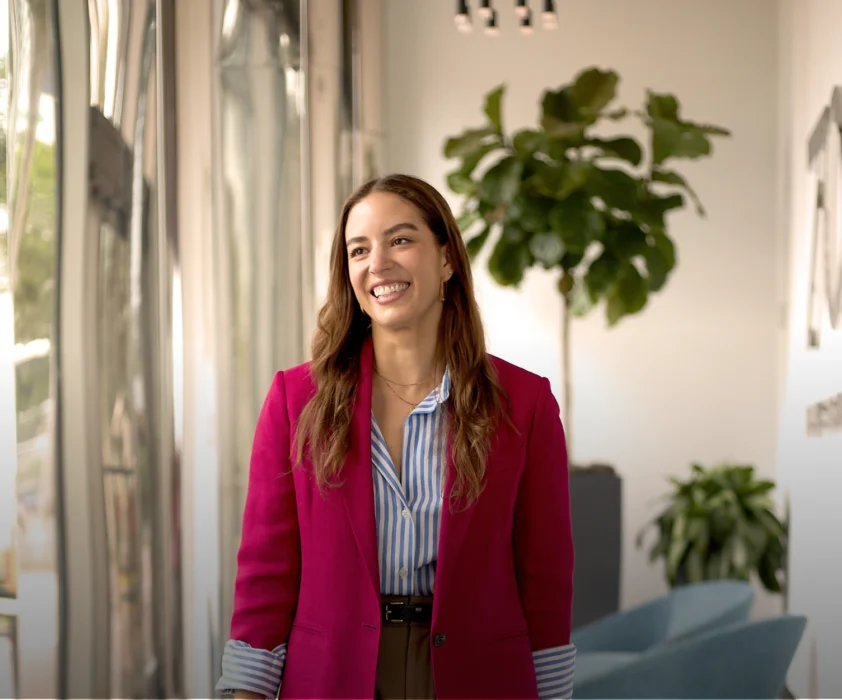
Forget corner offices and rows of cubicles.
Stream’s Corina Ocanto, vice president of workplace strategy, is reimagining the workplace for a new era, one where technology, human connection, and well-being converge. Her passion for creating spaces that truly serve people began with a surprising turn in her career path. “I started out studying architecture,” Corina explains, “but I quickly realized my true calling wasn’t constructing buildings, but shaping the experiences within them.”
This realization led her to the world of interior design and, eventually, to the specialized field of workplace strategy. Corina became fascinated by “design thinking,” a problem-solving approach that places human needs and experiences at its core. She uses this philosophy to understand how physical spaces can influence how people work, collaborate, and thrive.
Early in her career, Corina discovered her talent for connecting with clients and understanding their unique challenges. A pivotal project for a local accounting firm solidified her passion. Tasked with helping employees transition to a new headquarters, she became a trusted voice, gathering concerns and fostering a sense of empowerment during the change. Then came the pandemic, which fundamentally altered the future of work. “It became THE question,” she recalls. “Nobody had any idea what they were going to do next.” Companies suddenly had to rethink their spaces and work models, and Corina was there to guide them.
A HOLISTIC APPROACH TO WORKPLACE STRATEGY
Corina views the office as an ecosystem shaped by company culture, HR practices, and technology—not just physical space.
The Human Factor:
Her process begins with open discussions with HR to understand policies, employee needs, and how they impact space usage. “We have to pull in HR and ask them what they’ve tried and seen,” she says, emphasizing the importance of aligning space with company culture and employee well-being.
Technology as an Enabler:
With the rise of hybrid work, technology has become central to her approach. “We talk a lot about technology—not just for video conferencing, but also for things like digital twins,” she explains. These virtual models allow remote and in-office teams to collaborate seamlessly in a shared digital environment. Beyond connectivity, Corina sees technology as a way to enhance workplace flexibility and personalization. Smart sensors that monitor light, sound, and occupancy allow employees to choose spaces that suit their needs, boosting both productivity and comfort.
Data-Driven Design:
Corina leverages occupancy and utilization data to understand how employees interact with the space. Emerging technologies provide anonymous, behavior-based insights. “Are people meeting with others? Does their posture suggest collaboration?” she asks. This “behavioral research” informs the design of areas tailored for focus, social connection, and different work styles.
TAILORED SPACES, STRATEGIC ADVANTAGES
In today’s competitive landscape, Corina’s focus on customized design isn’t just a trend—it’s a strategic imperative. “People have to be very specific,” she insists, her voice radiating. “Forget generic offices designed solely around headcount. Every workspace element needs to be infused with intention, carefully crafted to support the company’s unique goals and attract and retain top talent.”
Corina acts as a detective, partnering with clients to uncover their hidden needs and aspirations. She doesn’t just design spaces; she crafts experiences that foster a powerful sense of belonging. This means considering not just the physical layout but also the nuances of the environment. An advocate for sustainability and wellness, she believes workspaces should nurture both people and the planet. This translates to designs that seamlessly integrate elements like:
- Light sensors that optimize natural light while minimizing energy consumption.
- Sound sensors that empower employees to curate their acoustic environment.
- Quiet corners for reflection and prayer rooms for spiritual practice.
- Outdoor terraces that blur the lines between indoors and out.
However, Corina’s vision extends beyond just creating comfortable and sustainable spaces. She sees a future where offices are vibrant ecosystems, teeming with diverse areas that cater to every need. “You’re going to see everything from traditional five-day-a-week workspaces to private areas for heads-down focus and even event-like spaces that celebrate the brand,” she explains, her eyes sparkling with possibility. This marks a significant shift away from rigid office layouts of the past toward dynamic, personalized environments that empower employees to choose how and where they work best.
This vision, coupled with her focus on customization, translates to a significant competitive advantage. “In a world where employees crave flexibility, personalization, and a sense of purpose, a thoughtfully designed workspace becomes a magnet for top talent, fostering creativity, collaboration, and ultimately, strengthening the company’s overall success.”
TECHNOLOGY WITH A HUMAN TOUCH
Corina recognizes that technology has the power to transform the workplace, but she believes in wielding it thoughtfully, like a precision tool rather than a blunt instrument. “Video conferencing has become ubiquitous,” she observes, “but it’s often misused. Instead of connecting people, it can isolate them, with employees huddled at their desks, disengaged from their surroundings.” This disconnect, she believes, stems from a failure to truly integrate technology with the physical workspace.
To combat this, Corina champions innovations that bridge the digital and physical realms. Intelligent camera systems that track individuals, facilitating more natural and engaging virtual interactions, and “smart” furniture that seamlessly integrates with technology, minimizing clutter and maximizing flexibility. When implemented thoughtfully, these tools can empower employees to connect and collaborate seamlessly, whether in the office or across the globe.
But technology is only one piece of the puzzle. “Building a strong community, especially in a hybrid work model, requires a concerted effort to foster genuine connection,” states Corina.
She believes managers play a crucial role in nurturing a culture of trust and engagement by encouraging open communication and creating opportunities for virtual and in person interaction. Corina also recognizes the need for new roles within organizations to champion the hybrid work model, bridging the gap between facilities, HR, and communication teams to ensure a seamless and integrated experience for all.
Whether leveraging technology thoughtfully, crafting sustainable and inclusive spaces, or fostering a sense of community, Corina’s focus remains firmly on creating work environments that empower employees to thrive. “Effective workplace strategy isn’t about a predetermined solution,” she reflects, “it’s about addressing underlying needs and creating spaces that truly serve the people who use them.”
In a world where work is increasingly fluid and dynamic, Corina’s vision offers a compelling roadmap for designing spaces that inspire, connect, and support today’s changing workforce.
